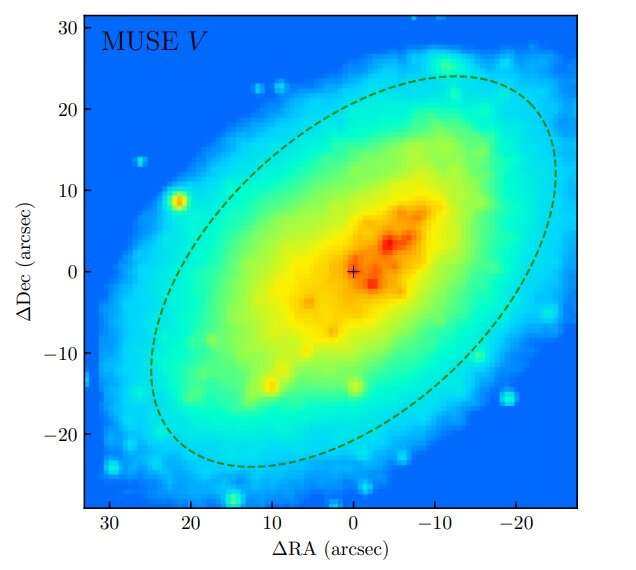October 20, 2022 report
Observations shed more light on the star formation history of galaxy NGC 2915

Using the Very Large Telescope (VLT), Chinese astronomers have investigated a nearby blue compact dwarf galaxy known as NGC 2915. Results of the study, presented in a paper published October 12 on arXiv.org, yield important insights regarding the star formation history of this galaxy.
Blue compact dwarfs (BCDs) are low-luminosity and low-metal content dwarf galaxies experiencing violent bursts of star formation. They are characterized by a compact optical appearance and H II-region-like spectra due to highly concentrated starburst activities.
At a distance of some 13.4 million light years, NGC 2915 (also known as PGC 26761) is one of the closest BCDs to Earth. It is an extreme case of BCDs in the local universe as its neutral atomic hydrogen (H I) gas content is very high and extremely extended in distribution. Moreover, almost all the young stellar populations and regions of ionized atomic hydrogen (H II) are located near the center of this galaxy.
However, although NGC 2915 is extremely rich in gas, the star formation activity is barely detected in its extended outer H I disk. Furthermore, the triggering mechanism of the highly concentrated star formation in this galaxy remains unclear.
Therefore, in order to further investigate the star formation activity in NGC 2915, a group of astronomers led by Yimeng Tang of the University of Science and Technology of China in Hefei, China, conducted a comprehensive analysis of deep integral field spectroscopic observations of the galaxy's central region made with VLT's Multi Unit Spectroscopic Explorer (MUSE).
"To unveil the starburst-triggering mystery of NGC 2915, we perform a comprehensive analysis of deep VLT/MUSE integral field spectroscopic observations that cover the central kiloparsec star-forming region," the researchers wrote in the paper.
The study found that global star formation in NGC 2915 peaked around a couple of billion years ago, when the most massive star cluster was formed. The results suggest that the most recent episode of bursty star formation took place around 50 million years ago, has lasted for about 50–100 million years and was responsible for the formation of some 3% of the galaxy's total stellar mass.
According to the research, episodes of bursty star formation similar to the most recent one may have recurred for less than four times in different locations in the last billion years. However, these episodes turned out to be largely confined within the galaxy's central region (with a radius of approximately 1,300 light years).
The study also found that the stellar disk of NGC 2915 exhibits a relatively weak but significant rotation within the central 1,600 light years in radius and that the stellar rotation axis appears to be anti-parallel to that of the extended neutral H I disk. This finding indicates that the recent episodes of bursty star formation have been sustained by externally accreted gas.
More information: Yimeng Tang et al, Unveiling the Formation of NGC 2915 with MUSE: A Counterrotating Stellar Disk Embedded in a Disordered Gaseous Environment. arXiv:2210.06485v1 [astro-ph.GA], arxiv.org/abs/2210.06485
© 2022 Science X Network





















